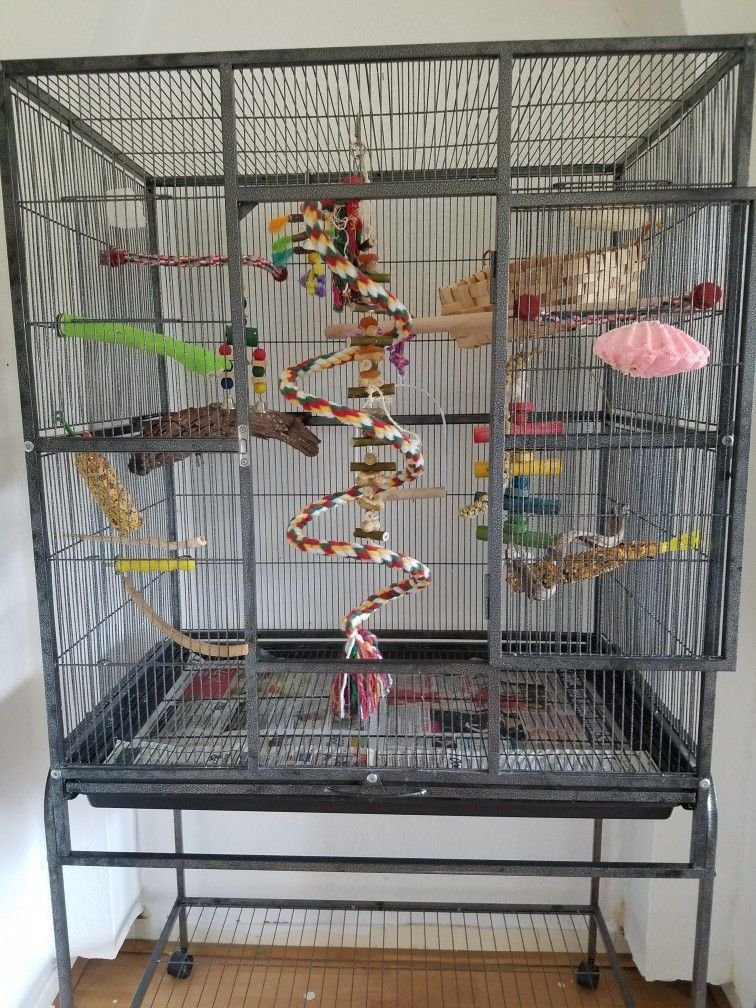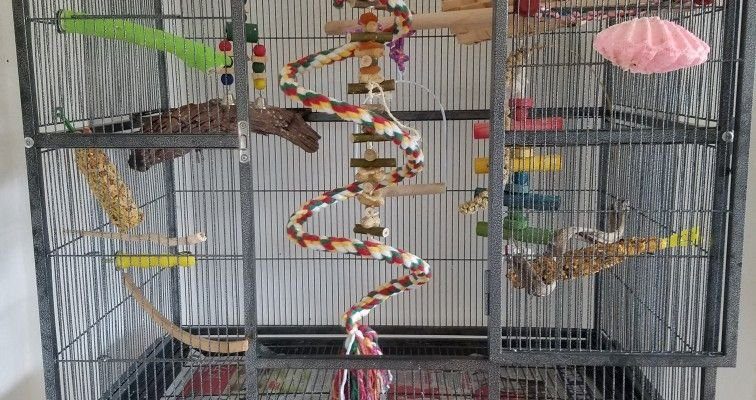
Imagine your cockatiel as a little explorer, eager to discover its surroundings. Just like a cozy home for us, your cockatiel’s cage should combine comfort and fun. The right cage setup encourages your bird to thrive, play, and express its natural behaviors. With the right knowledge, you can create a delightful sanctuary that meets your cockatiel’s needs.
So, what should you consider when setting up your cockatiel’s cage? Let’s break it down step by step.
Cage Size: How Big Is Big Enough?
When you’re selecting a cage for a cockatiel, size really matters. In fact, the bigger, the better! A spacious cage allows your bird to move around comfortably, stretch its wings, and play without feeling cramped. But how much space do they actually need?
The minimum recommended cage size for a single cockatiel is 24 inches wide, 24 inches deep, and 36 inches high. This size gives your feathery friend enough room to fly short distances and explore. However, if you can swing it, aim for a larger cage. An even bigger setup provides more opportunities for playtime and exercise.
Besides just the dimensions, think about the layout. The bars should be spaced no more than 1⁄2 inch apart to keep your cockatiel safe. If you have multiple birds, consider a cage that is taller rather than wider, as cockatiels typically enjoy climbing.
Choosing the Right Cage Material
Now that we’ve talked about size, let’s consider what the cage is made of. You might come across cages made from various materials—like metal, plastic, or wood. While each has its pros and cons, metal cages are often the most recommended for cockatiels.
Why metal, you ask? Metal cages are durable, easy to clean, and resistant to chewing. Remember, cockatiels love to nibble, so you want a material that can withstand some wear and tear. Look for stainless steel or powder-coated metal, as they are both safe and sturdy.
Avoid cages with toxic finishes or paints. As a rule of thumb, if you’re unsure about a cage material, ask the pet store for details or do a quick online search. Your goal is to create a safe haven, not a hazard.
Essential Perches: Types and Placement
Perches are more than just a place for your cockatiel to hang out—they’re crucial for their physical health. Different types of perches provide various textures and widths to help your bird exercise its feet and prevent boredom.
Natural wood perches are always a great option. They mimic what cockatiels would use in the wild and provide a comfortable grip. Concrete perches can help with nail trimming, but make sure they’re not too rough, as they can cause injuries.
When setting up your cage, place perches at different heights. This variety allows your cockatiel to hop from one to the other, mimicking natural movement. Here’s a tip: avoid placing a perch right above the food or water dishes. This position can lead to messiness, and no one likes a dirty dining area!
Fun and Engaging Toys
Toys are essential for keeping your cockatiel busy and entertained. Cockatiels are intelligent creatures, and they thrive on mental stimulation. Providing a variety of toys can prevent boredom and encourage healthy behaviors.
You might want to include:
- Chewing toys – Made from wood or paper, these allow your cockatiel to exercise its natural chewing instinct.
- Foraging toys – These toys encourage your bird to search for treats hidden inside, simulating a natural hunting behavior.
- Swings and ladders – These add movement and fun, letting your cockatiel climb and play.
Rotate the toys every few weeks to keep things fresh. It’s like giving your cockatiel a new adventure every time!
Setting Up Food and Water Stations
Food and water dishes should be easily accessible but placed thoughtfully. Go for sturdy ceramic or stainless-steel bowls to prevent tipping and spilling. Make sure the food dish is deep enough to hold a proper amount of food without waste and easy to clean.
For water, consider using a water bottle as it reduces mess and keeps water clean. However, some birds prefer bowls; if your cockatiel is one of them, choose a low-sided bowl for easy access.
Position these dishes at the same height as your cockatiel’s perches. Constantly ensuring fresh food and water is crucial for your bird’s health—just like us, they need to stay hydrated and nourished!
Lighting and Temperature: Creating a Comfortable Environment
Lighting and temperature play a significant role in your cockatiel’s well-being. Ensure the cage is in a spot with natural light, but avoid direct sunlight that can overheat the cage. A good balance is essential. You want to mimic a natural environment, which often means having a day and night cycle.
Keep the room temperature between 65 and 80 degrees Fahrenheit. Cockatiels can be sensitive to extreme temperatures, so ensure it’s not too hot or cold, particularly during winter months or heat waves.
If you can, consider getting a full-spectrum light. This light mimics natural sunlight and can help your cockatiel maintain a healthy sleep cycle and mood.
Regular Cleaning for Health and Happiness
A clean environment is vital for your cockatiel’s happiness and health. Regular cleaning prevents the buildup of bacteria and keeps odors at bay. Plan to do a thorough cleaning of the cage once a week, but spot clean daily.
To clean, remove everything from the cage—food dishes, toys, and perches. Use a bird-safe cleaner, or a simple mixture of vinegar and water works great. Ensure all components are rinsed well and dried before putting them back together.
Also, consider lining the bottom of the cage with newspaper or paper towels. It’s easy to remove and replace when things get messy.
Final Thoughts on Cage Setup
Creating the best cage setup for your cockatiel is about more than just choosing the right size and materials. It’s about crafting a lively, welcoming space that lets your bird thrive. Pay attention to the little details—like perch placement, the variety of toys, and cleaning routines—and your cockatiel will thank you with happy chirps and playful antics.
Remember, a well-set-up cage is like a cozy home for your feathered friend, encouraging exploration, play, and a happy, healthy life. So, get ready for a delightful journey as you welcome a new cockatiel into your home!

